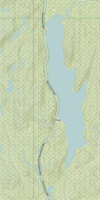|
Jacques-Cartier Lake
The lac Jacques-Cartier, main source of the Jacques-Cartier River, is a glacial lake located in the Laurentides Wildlife Reserve, about 90 km to the north of the city of Quebec, in the unorganized territory of Lac-Jacques-Cartier, in the La Côte-de-Beaupré Regional County Municipality, in the administrative region of Capitale-Nationale, in the province of Quebec, in Canada. The area around the lake is served by the route 175 which passes on the west shore, for the needs of forestry and recreational tourism activities.[1] Forestry is the main economic activity in this sector; recreational tourism, second. The surface of Lake Jacques-Cartier is usually frozen from the beginning of December to the end of March, however the safe circulation on the ice is generally made from mid-December to mid-March. GeographyThe main hydrographic slopes near Lac Jacques-Cartier are:
 The lake is located in the unorganized territory of Lac-Jacques-Cartier. The Nadreau Lake constitutes the head water body of the Jacques-Cartier River. This lake receives the waters on the west side of two small lakes: Plamondon lake (altitude: 844 metres (2,769 ft)) and an unnamed lake (862 metres (2,828 ft)). Lake Nadreau discharges 180 m north into Lake Grandpré (altitude: 847 m). The latter empties westwards into "Petit Pré lake" (440 m long; altitude: 838 m). From the mouth of "Lac Petit Pré", the Jacques-Cartier River flows 15.6 km northwest in the county of Montmorency to reach Lake Jacques-Cartier. Lake Jacques-Cartier, 9.2 km long, 1.8 km wide on average and 69 m deep, is the largest lake in the Laurentides Wildlife Reserve.[2][3] At an altitude of approximately 795 m, it borders, to the east, Mont Camille-Pouliot (1,006 metres or 3,301 feet).[4] At its southern end is a hydroelectric dam, built in 1922.[2] Between the lake and the mountain, pass boulevard Talbot[5](or route 175), same as a highway rest area called L'Étape. AttractionsIn this lake, you can fish for gray trout (lake trout[6][7]). There is also the "Petit lac Jacques-Cartier" (47°24′21″N 71°31′47″W / 47.405785°N 71.529751°W).[8] This is why we have long talked about the Great Jacques-Cartier Lake to distinguish it from the Small.[9] Galerie
ToponymyJacques Cartier (Saint-Malo, France, 1491 – Saint-Malo, 1557), explorer and navigator, made three trips to Canada between 1534 and 1542. He ventured to the New World in 1534, charged by François I to find gold and a passage to Asia. He explored the Anticosti Island, the Gulf of St. Lawrence and, on July 24, he erected a cross in the bay of Gaspé as a sign of 'appropriation of the premises. During his second journey, in 1535, Cartier went up the St. Lawrence River to Hochelaga (Montreal) and spent a difficult winter in Stadaconé (Quebec). Finally, in 1541, under the orders of Roberval, Cartier attempted to establish the first French colony in America. It attaches to the mouth of the Cap-Rouge river which it names Charlesbourg-Royal. Cartier left the colony in June 1542, while Roberval was on his way to Canada. They meet in Newfoundland, and Cartier chooses to return to Saint-Malo. First cartographer of the St. Lawrence, he recognized that the gold and diamonds found turned out to be iron pyrite and quartz.[10] The toponym "lac Jacques-Cartier" was formalized on December 5, 1968, by the Commission de toponymie du Québec.[11] Notes and references
See alsoWikimedia Commons has media related to Lac Jacques-Cartier. |
||||||||||||||||||||||||||||



